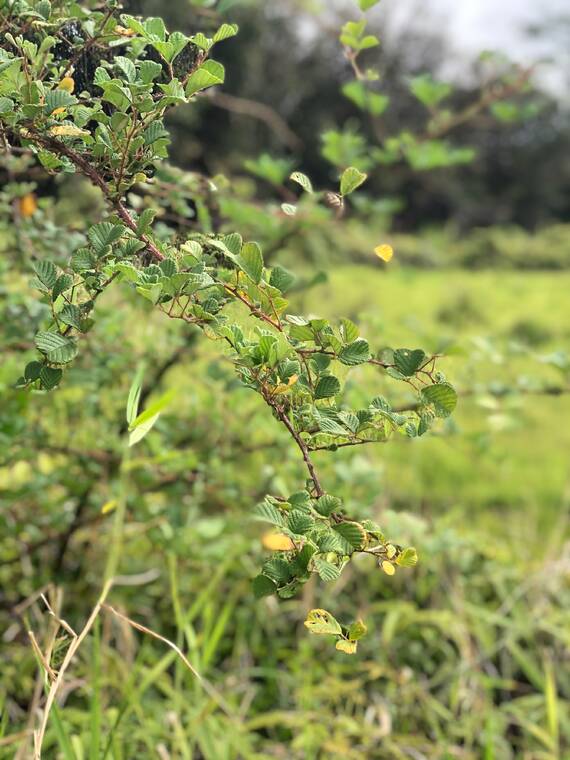Fern Forest subdivision in Puna will become the newest front in a war against an aggressive invasive plant spreading around the Big Island.
The yellow Himalayan raspberry, or Rubus ellipticus, is a hardy invasive weed that has become entrenched in the higher altitudes of the island over the last decade, and has been called one of the world’s 100 worst invasive plant species by the International Union for the Conservation of Nature’s Invasive Species Specialist Group.
Franny Brewer, program manager at the Big Island Invasive Species Committee, said the species is difficult to manage, because it is covered in thorns and can quickly reproduce and spread into a dense thicket — which also chokes out native plant species.
“If it’s on your property, you’re fighting it all the time, whether you want to or not,” Brewer said.
The weed is present throughout lower Puna, Brewer said, and has become particularly entrenched in the Fern Forest subdivision, where raspberry bushes can cluster so close to the roads that they can scratch vehicles.
“It’s a huge problem,” said Fern Forest Community Association President Melissa Fletcher. “It’s like a hydra. You can cut one down, but every root left behind will grow a whole new runner of baby plants.”
But Fern Forest will be a test ground for BIISC to develop new methods to manage the weed, thanks to $7,500 in funding granted Wednesday to BIISC by the Hawaii County Council.
“The last published control information about the raspberry came out like more than 20 years ago,” Brewer said. “And almost all of that research was targeted toward large landowners, like farmers or ranchers. A lot of that research isn’t practical for homeowners.”
To that end, BIISC will be working with a cadre of volunteers to test a variety of potential products to kill the weed on private properties in Fern Forest.
Brewer said Fern Forest residents already have developed an updated map of the parcels where the weeds are found. As of Friday, that map appeared to highlight nearly half the subdivision.
Brewer said the potential products that will be used to battle the invasive plant include a variety of pesticides and pesticide mixtures, as well as home solutions like vinegar. Because the tests need to observe results over time, she said the work in Fern Forest should take about a year to complete.
Fletcher emphasized that none of the pesticides to be tested will include glyphosate, adding that a key component of the testing is finding a product that has the least impact to the surrounding environment and human health.
For her part, Fletcher said she manages the raspberries on her property with goats.
“There was a building on our property that we didn’t even know we had,” Fletcher said, explaining that the building was so wholly engulfed in a raspberry thicket that it could not be seen. Eventually, she said, she used a mulcher to shred the thicket and relies on goats to prevent the weeds from growing back.
Testing in Fern Forest might not begin for some time, however. Brewer noted that the rainy season is about to begin, which may forestall pesticide testing for a while.
“But it’s exciting to finally be able to schedule this,” Brewer said. “We’ve been waiting on this money since like November, so it’s been on the back burner for a while.”
Email Michael Brestovansky at mbrestovansky@hawaiitribune-herald.com.






